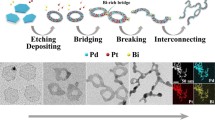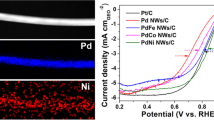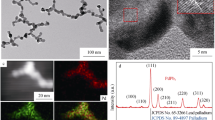Abstract
Less-expensive but efficient electrocatalysts are essential to accelerate the commercialization of fuel cells. Herein, ultrathin PdPb nanowires (PdPb NWs) with a diameter of around 3.5 nm were prepared by using a one-step hydrothermal method. The introduction of Pb in Pd-based bimetallic nanostructures produced high differences in the morphology from Pd nanoparticles (NPs) to various PdPb NWs. All the as-prepared PdPb NWs exhibited better electrocatalytic activity and durability than Pd NPs due to the synergistic effect. Especially, Pd65Pb35 possessed the highest current density of about 3460 mA mgPd−1 for the ethanol electrooxidation which was around 6.3 times higher than commercial Pd/C. The high-performance of Pd65Pb35 is attributed to the defect-rich and stable nanowire structure with optimized surface atomic arrangement, as evidenced by high resolution transmission electron microscopy measurements and long-time treatment in an acidic media. The differences in the morphologies and electrocatalytic activities of PdPb NWs with varied Pb contents have also been discussed and analyzed.
摘要
价格低廉且高效的电催化剂是加速燃料电池商业化的关键. 本文采用一步水热法制备出直径约3.5 nm的超细PdPb纳米线. 在 钯基双金属纳米结构中引入铅后, 不同组成的PdPb纳米线与钯纳 米颗粒的形貌差异较大. XRD、TEM、XPS和电化学表征结果证 实, 由于双金属间的协同效应, PdPb纳米线的电催化活性和耐久性 均优于钯纳米颗粒. 其中, Pd65Pb35的乙醇电氧化电流密度最高, 可 达3460 mA mgPd−1, 约为商业Pd/C的6.3倍. HRTEM测试和经酸性 介质长期处理后的表征结果显示, Pd65Pb35表面原子的优化排列和 丰富的缺陷使其表现出高性能. 此外, 本文讨论和分析了不同铅含 量的PdPb纳米线之间形貌和电催化活性的差异.
Similar content being viewed by others
References
Zhang Z, Wu Q, Mao K, et al. Efficient ternary synergism of platinum/tin oxide/nitrogen-doped carbon leading to high-performance ethanol oxidation. ACS Catal, 2018, 8: 8477–8483
Jiang K, Bu L, Wang P, et al. Trimetallic PtSnRh wavy nanowires as efficient nanoelectrocatalysts for alcohol electrooxidation. ACS Appl Mater Interfaces, 2015, 7: 15061–15067
Chen A, Ostrom C. Palladium-based nanomaterials: synthesis and electrochemical applications. Chem Rev, 2015, 115: 11999–12044
Chen C, Kang Y, Huo Z, et al. Highly crystalline multimetallic nanoframes with three-dimensional electrocatalytic surfaces. Science, 2014, 343: 1339–1343
Debe MK. Electrocatalyst approaches and challenges for automotive fuel cells. Nature, 2012, 486: 43–51
Li M, Zhao Z, Cheng T, et al. Ultrafine jagged platinum nanowires enable ultrahigh mass activity for the oxygen reduction reaction. Science, 2016, 354: 1414–1419
Gilroy KD, Ruditskiy A, Peng HC, et al. Bimetallic nanocrystals: syntheses, properties, and applications. Chem Rev, 2016, 116: 10414–10472
Zhang Y, Wu B, Tang Y, et al. Prolonged electron lifetime in ordered TiO2 mesophyll cell-like microspheres for efficient photocatalytic water reduction and oxidation. Small, 2016, 12: 2291–2299
Zhang Z, Gong Y, Wu D, et al. Facile fabrication of stable PdCu clusters uniformly decorated on graphene as an efficient electro-catalyst for formic acid oxidation. Int J Hydrogen Energy, 2019, 44: 2731–2740
Xue J, Han G, Ye W, et al. Structural regulation of PdCu2 nanoparticles and their electrocatalytic performance for ethanol oxidation. ACS Appl Mater Interfaces, 2016, 8: 34497–34505
Mori K, Sano T, Kobayashi H, et al. Surface engineering of a supported PdAg catalyst for hydrogenation of CO2 to formic acid: Elucidating the active Pd atoms in alloy nanoparticles. J Am Chem Soc, 2018, 140: 8902–8909
Wang C, Song P, Gao F, et al. Precise synthesis of monodisperse PdAg nanoparticles for size-dependent electrocatalytic oxidation reactions. J Colloid Interface Sci, 2019, 544: 284–292
Xu H, Yan B, Zhang K, et al. Self-supported worm-like PdAg nanoflowers as efficient electrocatalysts towards ethylene glycol oxidation. ChemElectroChem, 2017, 4: 2527–2534
Zhu C, Shi Q, Fu S, et al. Core-shell PdPb@Pd aerogels with multiply-twinned intermetallic nanostructures: facile synthesis with accelerated gelation kinetics and their enhanced electro-catalytic properties. J Mater Chem A, 2018, 6: 7517–7521
Gong Y, Liu X, Gong Y, et al. Synthesis of defect-rich palladiumtin alloy nanochain networks for formic acid oxidation. J Colloid Interface Sci, 2018, 530: 189–195
Dandan Tu, Wu B, Wang B, et al. A highly active carbon-supported PdSn catalyst for formic acid electrooxidation. Appl Catal B-Environ, 2011, 103: 163–168
Bu L, Shao Q, Huang X. Highly porous Pt-Pb nanostructures as active and ultrastable catalysts for polyhydric alcohol electro-oxidations. Sci China Mater, 2019, 62: 341–350
Zhang Y, Tang Y, Liu X, et al. Three-dimensional CdS-titanate composite nanomaterials for enhanced visible-light-driven hydrogen evolution. Small, 2013, 9: 996–1002
Jiang Z, Tang Y, Tay Q, et al. Understanding the role of nanostructures for efficient hydrogen generation on immobilized photocatalysts. Adv Energy Mater, 2013, 3: 1368–1380
Feng Y, Bu L, Guo S, et al. 3D platinum-lead nanowire networks as highly efficient ethylene glycol oxidation electrocatalysts. Small, 2016, 12: 4464–4470
Li H, Sang J, Zhao J, et al. Preparation of magnetically separable mesoporous Co@carbon/silica composites by the RAPET method. New J Chem, 2012, 36: 2308–2315
Chen K, Jiao T, Li J, et al. Chiral nanostructured composite films via solvent-tuned self-assembly and their enantioselective performances. Langmuir, 2019, 35: 3337–3345
Gaddam RR, Yang D, Narayan R, et al. Biomass derived carbon nanoparticle as anodes for high performance sodium and lithium ion batteries. Nano Energy, 2016, 26: 346–352
Zhao F, Yuan Q, Luo B, et al. Surface composition-tunable octahedral PtCu nanoalloys advance the electrocatalytic performance on methanol and ethanol oxidation. Sci China Mater, 2019, 62: 1877–1887
Ma N, Liu X, Yang Z, et al. Carrageenan asissted synthesis of palladium nanoflowers and their electrocatalytic activity toward ethanol. ACS Sustain Chem Eng, 2018, 6: 1133–1140
Xu H, Song P, Fernandez C, et al. Sophisticated construction of binary PdPb alloy nanocubes as robust electrocatalysts toward ethylene glycol and glycerol oxidation. ACS Appl Mater Interfaces, 2018, 10: 12659–12665
Zhong JH, Jin X, Meng L, et al. Probing the electronic and catalytic properties of a bimetallic surface with 3 nm resolution. Nat Nanotech, 2016, 12: 132–136
Ma Y, Gao W, Shan H, et al. Platinum-based nanowires as active catalysts toward oxygen reduction reaction: In situ observation of surface-diffusion-assisted, solid-state oriented attachment. Adv Mater, 2017, 29: 1703460
Huang L, Han Y, Zhang X, et al. One-step synthesis of ultrathin Ptxb nerve-like nanowires as robust catalysts for enhanced methanol electrooxidation. Nanoscale, 2017, 9: 201–207
Lv Z, Luo Y, Tang Y, et al. Editable supercapacitors with customizable stretchability based on mechanically strengthened ultralong MnO2 nanowire composite. Adv Mater, 2018, 30: 1704531
Yang F, Ye JY, Yuan Q, et al. Ultrasmall Pd-Cu-Pt trimetallic twin icosahedrons boost the electrocatalytic performance of glycerol oxidation at the operating temperature of fuel cells. Adv Funct Mater, 2020, 30: 1908235
Luo B, Zhao F, Xie Z, et al. Polyhedron-assembled ternary PtCuCo nanochains: Integrated functions enhance the electrocatalytic performance of methanol oxidation at elevated temperature. ACS Appl Mater Interfaces, 2019, 11: 32282–32290
Zhao W, Huang D, Yuan Q, et al. Sub-2.0-nm Ru and composition-tunable RuPt nanowire networks. Nano Res, 2016, 9: 3066–3074
Wang Q, Wang Y, Guo P, et al. Formic acid-assisted synthesis of palladium nanocrystals and their electrocatalytic properties. Langmuir, 2014, 30: 440–446
Zhang LY, Wu D, Gong Y, et al. Carbon monoxide-templated synthesis of coral-like clean PtPd nanochains as efficient oxygen reduction catalyst. ChemElectroChem, 2018, 5: 2403–2408
Wang YQ, Liang WS, Geng CY. Shape evolution of gold nanoparticles. J Nanopart Res, 2010, 12: 655–661
Zhang K, Bin D, Yang B, et al. Ru-assisted synthesis of Pd/Ru nanodendrites with high activity for ethanol electrooxidation. Nanoscale, 2015, 7: 12445–12451
Tang Y, Jiang Z, Xing G, et al. Efficient Ag@AgCl cubic cage photocatalysts profit from ultrafast plasmon-induced electron transfer processes. Adv Funct Mater, 2013, 23: 2932–2940
Wang X, Yang J, Yin H, et al. “Raisin Bun”-like nanocomposites of palladium clusters and porphyrin for superior formic acid oxidation. Adv Mater, 2013, 25: 2728–2732
Wang Y, He Q, Wei H, et al. Optimal electrocatalytic Pd/MWNTs nanocatalysts toward formic acid oxidation. Electrochim Acta, 2015, 184: 452–465
Qu X, Cao Z, Zhang B, et al. One-pot synthesis of single-crystalline PtPb nanodendrites with enhanced activity for electrooxidation of formic acid. Chem Commun, 2016, 52: 4493–4496
Sun J, Zhang C, Kou T, et al. Anodization of Pd in H2SO4 solutions: Influence of potential, polarization time, and electrolyte concentration. ACS Appl Mater Interfaces, 2012, 4: 6038–6045
Liu H, Adzic RR, Wong SS. Multifunctional ultrathin PdxCu1-x and Pt∼PdxCu1-x one-dimensional nanowire motifs for various small molecule oxidation reactions. ACS Appl Mater Interfaces, 2015, 7: 26145–26157
Xu C, Liu A, Qiu H, et al. Nanoporous PdCu alloy with enhanced electrocatalytic performance. Electrochem Commun, 2011, 13: 766–769
Hong W, Shang C, Wang J, et al. Bimetallic PdPt nanowire networks with enhanced electrocatalytic activity for ethylene glycol and glycerol oxidation. Energy Environ Sci, 2015, 8: 2910–2915
Qi K, Wang Q, Zheng W, et al. Porous single-crystalline palladium nanoflowers with enriched {100} facets for highly enhanced ethanol oxidation. Nanoscale, 2014, 6: 15090–15097
Wang YH, Liang MM, Zhang YJ, et al. Probing interfacial electronic and catalytic properties on well-defined surfaces by using in situ Raman spectroscopy. Angew Chem Int Ed, 2018, 57: 11257–11261
Li C, Yuan Q, Ni B, et al. Dendritic defect-rich palladium-copper-cobalt nanoalloys as robust multifunctional non-platinum electrocatalysts for fuel cells. Nat Commun, 2018, 9: 3702
Sun Y, Liang Y, Luo M, et al. Defects and interfaces on PtPb nanoplates boost fuel cell electrocatalysis. Small, 2018, 14: 1702259
Hu C, Cheng H, Zhao Y, et al. Newly-designed complex ternary Pt/PdCu nanoboxes anchored on three-dimensional graphene framework for highly efficient ethanol oxidation. Adv Mater, 2012, 24: 5493–5498
Acknowledgements
This work was financially supported by the National Natural Science Foundation of China (21773133) and Taishan Scholars Advantageous and Distinctive Discipline Program for supporting the research team of energy storage materials of Shandong Province, China.
Author information
Authors and Affiliations
Contributions
The manuscript was written through contributions of all authors. All authors have given approval to the final version of the manuscript.
Corresponding authors
Additional information
Conflict of interest
The authors declare no competing financial interest.
Supplementary information
Supporting data are available in the online version of the paper.
Ning Ma received his MSc degree from the School of Materials Science and Engineering, Qingdao University, under the direction of Prof. Peizhi Guo. His current research interests focus on the synthesis and electrocatalytic properties of noble metal based nanomaterials.
Shuqing Wang is a third-year graduate student in Prof. Peizhi Guo’s group at the School of Materials Science and Engineering, Qingdao University. Her current research interests focus on the synthesis and characterization of nano-materials for electrocatalysis and supercapacitor.
Lian Ying Zhang received his PhD degree in 2014 under the supervision of Prof. Chang Ming Li from the Southwest University. After that, he worked as a postdoctor in Prof. Li’s group. In 2016, he joined the Institute of Materials for Energy and Environment of Qingdao University as an associate professor. His research interests focus on advanced nanomaterials for electrochemical applications such as fuel cells and electrocatalysis.
Peizhi Guo received his BSc degree in Liaocheng University (1998), MSc degree in Shandong University (2003) and PhD degree in the Institute of Chemistry, Chinese Academy of Sciences (2006). He joined Qingdao University as an associate professor in 2006, and became a full professor in 2013. His current research interests focus on the design, synthesis and self-assembly of nanoparticles for electrocatalysis and energy storage.
Supplementary Information
Rights and permissions
About this article
Cite this article
Ma, N., Wang, S., Liu, X. et al. PdPb bimetallic nanowires as electrocatalysts for enhanced ethanol electrooxidation. Sci. China Mater. 63, 2040–2049 (2020). https://doi.org/10.1007/s40843-020-1350-7
Received:
Accepted:
Published:
Issue Date:
DOI: https://doi.org/10.1007/s40843-020-1350-7




